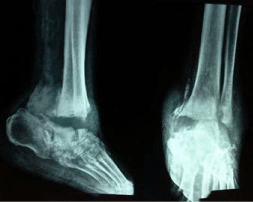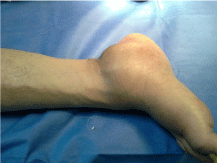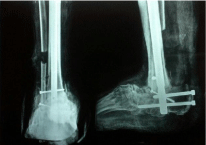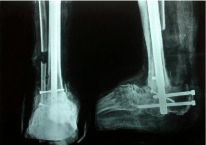Abstract
Background: The aim of this study was to assess the results of tibiotalocalcaneal arthrodesis in patients with Charcot arthropathy of the hindfoot and its effect on the quality of life of the egyptian patients.
Materials and Methods: Seventeen patients with diabetic Charcot arthropathy of the hind foot with either pain or instability where managed by tibiotalocalcaneal arthrodesis with intramedullary nailing using the supracondylar femoral nails. The American Orthopaedic Foot and Ankle Society (AOFAS) ankle/hindfoot scale, the Short Form-36 (SF-36) questionnaire and the Foot Function Index (FFI) were used to assess the results.
Results: The mean AOFAS score, the foot function index and SF-36 scale were improved significantly by the last follow up.
Pain, function and activity of daily life were significantly improved and the limitations of function were significantly reduced by the last follow up when measured by the AOFAS, FFI and SF-36 scales P< 0.001. All the eight health concepts of the SF-36 score were significantly improved; for emotional well being P< 0.014 and for the other 7 concepts P < 0.001.
Conclusion: Tibiotalocalcaneal arthrodesis in patients with Charcot arthropathy of the hind foot through the supracondylar femoral nails is a reliable method with a high union rate and a highly positive impaction on the quality of life in Egyptian patients.
Keywords: Charcot joint; Tibiotalocalcaneal arthrodesis; Quality of life; Intramedullary nail.
Abbreviations
AOFAS: The American Orthopedic Foot and Ankle Society; SF-36: The Short Form-36; FFI: Foot Function Index; CAN: Charcot Neuroarthropathy; TTCA: Tibiotalocalcaneal Arthrodesis
Introduction
Diabetes is considered a one of the diseases with a high prevalence, about 15% of diabetic patients are complicated with foot ulcers and 1% requires high-level amputation resulting in loss of employment and psychic disorders [1]. Charcot Neuroarthropathy (CNA) is characterized by a collapse of the arches of the foot mainly at the joints level due to degeneration of the articular cartilage causing subluxation and dislocation of the joints. The deformity may be associated with a bony prominence that may cause pressure sores [2].
Charcot arthropathy affects mainly the midfoot leading to osteolysis and fractures but also occurs in the forefoot and hindfoot [3].
Many deformities due to Charcot arthropathy that was treated with amputations are now treated with salvage procedures with improving results [4-8].
Arthrodesis can be the solution of the problem of instability, pain or recurrent ulcerations that is not responsive to conservative therapy [2,3].
Arthrodesis in cases of CNA is not that easy task due to causes related to scar tissue, bone fractures, weak osteopenic bone or deformities [9].
Hindfoot arthrodesis through rigid internal fixation after correcting the deformity offered a painless stable, plant igrade foot with intact skin, this leads to improved patient and surgeon satisfaction [2].
Although intramedullary nailing to achieve Tibiotalocalcaneal Arthrodesis (TTCA) is an old method. It is still a point of debate in CAN as regard union rates and complications [10,11].
The goal of this study was to assess the results of treating patients with Charcot arthropathy of the hind foot through TTCA with a retrograde intramedullary nail, and to assess the effect of this treatment on the patient's quality of life [10].
Materials and Methods
From May 2009 to October 2014, seventeen patients with diabetic Charcot arthropathy of the hind foot with either pain or instability where managed in Mansoura university hospitals by TTCA with intramedullary nailing using the supracondylar femoral nails. There were 10 women and 7 men, all patients had no ulceration or bone infection none of them had a previous operation for the foot. Mean age was 49 years (range 39-58years).

Figure 1: Pre-operative X rays for a 48 years old man with diabetic Charcot arthropathy of the hindfoot.

Figure 2: Preoperative photo of the foot of the same patient in (Figure 1).

Figure 3: X-rays at the last follow up for the same patient in (Figure 1).
Showing the intra medullary nail in place with union of the arthrodesis, the
distal fibula is fixed to the tibia and talus by screws.

Figure 4: A photo of the foot of the same patient in (Figure 1) after union.
The American Orthopaedic Foot and Ankle Society (AOFAS) ankle/hindfoot scale was used to assess the patients preoperative and at the last follow up, the Short Form-36 (SF-36) questionnaire and the Foot Function Index (FFI) were used to assess the quality of life of the patients preoperative and at the last follow up [12-14].
American Orthopedic Foot & Ankle Society (AOFAS) hind foot score is 100 points score that includes 40 points for pain, 50 for function and 10 points for alignment, it was assessed preoperative and at the last follow up [12].
The Short Form-36 (SF-36) questionnaire [13] addresses eight health concepts: physical functioning, bodily pain, role limitations due to physical health problems, role limitations due to personal or emotional problems, emotional well-being, social functioning, energy/fatigue, and general health perceptions, the questionnaire was scored according to the Scoring Rules for the RAND 36-Item Health Survey (Version 1.0).
The FFI is divided into three subscales which provide information on foot pain, disability and activity limitation due to foot pathology. The patient expresses his experience in the past week pain is expressed on a visual analogue scale ranging from “no pain” to “worst pain imaginable”.
The disability scale measures the difficulty in performing various activities due to foot problems with a visual analogue scale ranging from “no difficulty” to “so difficult unable to do”.
The activity limitation subscale measures activity limitations due to foot problems according how much of time the patients faces this limitation where the most sever limitation is expressed as “all of the time” and no limitation as “none of the time” [14].
Surgical technique
Surgery was performed under either general or spinal anesthesia. With the patient supine on a radiolucent operating table, a pneumatic tourniquet was applied to the thigh.
A lateral incision extending from the distal third of the fibula to the cuboid, all soft tissues around the distal fibula was dissected and elevated except for the calcaneofibular ligament, using a bone saw a fibular osteotomy was done, the distal fibula was then turned down thus the ankle and subtalar are now visualized.
The particular cartilage of both the ankle and the subtalar joints is carefully removed till healthy cancellous bone is reached. All dead bones and fibrous tissue are removed. The adjacent surfaces of the distal fibula, tibia, and talus are decorticated; the fibula is then reduced to its position and fixed with a screw to the tibia and another one to the talus so that the fibula acts as a vascularized graft increasing the potentiality for union.
A technical trick is to align the talus and calcaneus; calcaneus must be translated medially for proper positioning as it lays one cm lateral to the lateral malleolus.
Last fu.
SF-36Pre op
SF-36Last fu.FFI
Pre op FFI
Last Follow up AOFOS
Pre op
AOFOSsex
age
86.1
35.6
27.6
70.6
77
18
F
40
1
89.6
17.1
30
74.7
81
22
F
49
2
65.8
38.1
28.8
84.1
79
22
M
46
3
41.5
31
32.4
78.8
patients
26
F
43
4
77.9
51.8
29.4
79.4
69
46
M
39
5
93.9
25.6
28.2
75.8
77
36
F
47
6
89.2
53.1
32.9
80.6
69
18
M
46
7
84.9
39.9
31.2
84.1
81
22
M
42
8
88.2
39.7
30
78.2
77
26
F
50
9
80
13.3
32.4
71.8
79
22
M
54
10
62.6
19.6
25.3
77.06
78
23
F
58
11
77.8
42.6
27.6
74.7
74
18
F
50
12
71
12.9
30.6
77.5
69
23
F
49
13
88.5
58.2
32.4
73.5
77
22
M
42
14
62.9
12.1
28.2
72.4
81
26
F
45
15
73.8
64.9
30.6
76.5
86
22
M
55
16
48.1
19.9
31.2
81.8
77
18
F
43
17
75.4
33.8
30.1
77
77
24.11
46.9
mean
Table 1: Demonstrates the results of the AOFOS, FFI and SF-36 scores preoperative and at the last follow up.
Medialization allows the nail to pass through the body of the calcaneus and not just abutting its medial wall otherwise fracture of the medial cortex of the calcaneus, neurovascular injury, loss of fixation, and /or deformity may occur.
The proper position for arthrodesis is in neutral dorsiflexion and 50 of heel valgus and about 5° to 10° of foot external rotation. Image intensification is necessary to assess alignment [15].
Provisional fixation can be obtained with Steinmann pins. An IM supra condylar femoral nail is then delivered retrograde; the entry point should be anterior to the weight bearing area of the calcaneus and slightly lateral to preserve neurovascular structures. The nail is directed so that the distal locking screws are directed from posterior to anterior through the talus and calcaneus, bone graft is required to fill defects that resulted after adequate debridement.
This procedure is performed under image to ensure appropriate alignment, screw purchase and appropriate nail length.
The nail length should extend beyond the distal isthmus of the tibia. Longer nails provide better stability and less stress rising effect, the proximal screws may be abandoned to allow compression through axial loading with weight bearing [15].
The patients instructed for partial-weight bearing in a cast until radiological union is identified, the patients were then instructed for permanent protective bracing.
Patients were followed up at 2 weeks post-operative and then every month till union was achieved then every 6 months till the last follow up, in each follow up visit the feet were assessed carefully as regard skin condition, vascularity, deformity and signs of infection if any. X rays were done in each visit till union was achieved and every 6 months thereafter till the last follow up.
Statistical analysis
The data of patients were statistically assessed using the Statistical Package for Social Sciences (SPSS) version 19. The mean value is the sum of all observations divided by the number of observations; the standard deviation is the measure of scatter of individual varieties around their mean. Paired sample test was used to define relations between functional outcomes preoperative and at the last follow up, it is used to compare the average for measurements made twice within the same person. Probability values of less than 0.05 were considered significant.
Results
Figures (1-4) sixteen cases (94.1%) were radiologically united within a mean period of 5.1months (range 3 to 13 months), one case (5.9%) developed delayed deep infection in spite of union and walking with a brace and refusing amputation, two cases (11.8%) of superficial infections which resolved under antibiotic therapy. Two patients (11.8%) had delayed union with pain and underwent second operations for extra bone grafting; one patient (5.9%) developed fibrous union without pain or instability and was satisfied with this result. Patients were followed for a mean period of 39 months (range, 15-60 months).
The mean AOFAS score improved significantly from 24.1 (range, 18-46) preoperatively to 77 (range, 69-86) by the last follow up (P < 0.01).
The foot function index improved significantly from a preoperative mean of 77 (range: 70.6 to 84) points to 30.1 (range: 32.4 to 27.6) points by the last follow up (P <0.01).
The mean SF-36 score improved significantly from a preoperative mean of 33.8 (range: 12.1 to 64.9) points to 75.4 (range: 41.5 to 93.9) points by the last follow up (P < 0.01) (Table 1).
The patients in this study had a significant improvement of pain at the last follow up as compared to the preoperative pain when measured by the AOFAS (14.7.1 improved to 31.7) and FFI (82.6 improved to 38.9) and SF-36 scales (39.5 improved to 71) (P < 0.001).
The function and activity of daily life were significantly improved and the limitations of function were significantly reduced as evaluated by the AOFAS, FFI and SF-36 score by the last follow up and this was statistically significant (P < 0.001).
All the eight health concepts of the SF-36 score were significantly improved (P< 0.001 for all except for emotional well being where P < 0.014). 15 out of 17 (88.2%) patients returned back to their previous occupation.
Discussion
Charcot Neuroarthropathy (CNA) of the foot and ankle is a challenge for the orthopedic surgeon.
Diabetes is considered nowadays the commonest cause of CNA, it mostly involves the foot specially the mid foot and ankle joints [16].
1-2.5% of diabetic patients are complicated with Charcot foot. It is mostly unilateral but it may be bilateral in about 25% of patients [17].
Charcot arthropathy is associated with bone fragmentation that may affect ankle stability. It may cause medial column collapse and forefoot abduction deformity resulting in ulcers on the medial side of the foot which may be complicated with a sever deep infection to the extent that requires amputation [18].
It is commonly associated with gastronemius contracture and shortening of the Achilles tendon which adds more to the deformity [18].
Patients with Charcot arthropathy have swelling, redness and hotness around the joints; with little or no pain. The absence of pain allows the patient to walk which increases the traumatic effect to the joints. Also loss of sensation and the presence of deformity with pressure on bony prominences results in ulceration [18].
Screening for the foot at risk is very important, diabetic patient with a warm and swollen foot is supposed to be at risk of developing Charcot. Diffuse osteopenia is also a radiological finding that may be used as a screening tool [2].
Hot skin is a good screening tool specially on comparing the healthy and affected feet. Casting at this stage reliefs the acute Charcot and prevents its progress [2].
CNA is due to a combination of neurovascular impairment, peripheral sensory, motor and autonomic neuropathy and biomechanical factors [19].
Motor neuropathy disturbs the integrity of the arch of the foot causing deformity; this deformity leads to imbalance of load distribution with pressure areas on bony prominences. Sensory disturbance combined with repeated trauma leads to micro fractures, instability of joints and bone damage. Autonomic neuropathy causes vasodilatation in the small arteries leading to bone resorption [20,21].
CNA is primarily managed non-operative, surgery is essential in certain indications. Long-lasting cast or brace is the conservative treatment for neuropathic foot sometimes it is not applicable and cumbersome to the patient in presence of sever deformities; arthrodesis, soft tissue operations, or both may be the solution [22].
The aim of surgery is to achieve a stable, functioning, palantegrade foot. In CNA the rate of nonunion, malunion, and infection is relatively high [8,22].
Hind foot arthrodesis in CNA has different union rates in different studies ranging from 36% to 93% [6,23,24].
Huang PJ et al. Had an average time to union of 8.75 months [22].
TTCA is indicated for severe deformity, instability, and arthritis of the ankle and/or subtalar joints in which ankle arthrodesis alone cannot solve the problem [5,22].
Huang PJ et al. Claimed that TTCA is indicated in cases where the ankle and subtalar joints are both arthritic or after failure of fusion for the neuroarthropathic ankle, and that TTCA only to provide a more rigid fixation of ankle fusion is not a strong indication as a nonunion rate of 14% and 26% were still reported by Kile et al. And Moore et al. Respectively [5,22,25].
TTCA alter both the hindfoot and forefoot motions. In TTCA the subtalar joint must be positioned in version to allow normal Cho part joints motion as the remaining foot motion occurs in the Cho part and Lisfrancjoint [22].
Deformity should be completely corrected; rigid internal fixation with bone grafting followed by prolonged immobilization and limited weight bearing. If this is not possible amputation may be indicated [2].
The traditional surgery of a below-knee amputation for management of Charcot foot has been changed towards salvage procedures [18].
Reconstruction procedures are indicated when the soft tissues are at risk, the foot is unstable or deformity makes the foot wearing difficult. Correction of the deformity and arthrodesis of the affected joints is the procedure of reconstruction required with or without gastrocnemius or Achilles tendon lengthening [18].
Diabetic patients mostly have low activity levels and saving their limb is associated with a high degree of satisfaction [4-8].
In this study tibiotalocalcaneal arthrodesis in patients with Charcot arthropathy of the hind foot improves significantly the quality of life of the patients; it significantly improved pain, function, activity of daily life, emotional wellbeing and social function. There are significant improvements of AOFAS, FFI and SF-36 score.
Colman et al. In their study on Transfibular Ankle Arthrodesis with Rigid Internal Fixation had AOFAS ankle-hind foot score improved significantly in their patients a finding comparable with our results [26].
Smith et al. found a significant increase of AOFAS and Visual Analogue Scale (VAS), with AOFAS improved from 39 preoperatively to 69 post-operatively and VAS was also improved from 8.3 points to 2 point [27].
Caixeta et al. In their study on tibiotalocalcaneal arthrodesis with retrograde intramedullary nailing found that the operation had significantly improved the AOFAS of their patients [28].
Conclusion
Tibiotalocalcaneal arthrodesis in patients with Charcot arthropathy of the hind foot through the supracondylar femoral nails is a reliable method with a high union rate and a highly positive impaction on the quality of life in Egyptian patients.
References
- Varma AK, Mangalanandan TS, Kumar H. Amrita Sling Technique: A novel method of foot and ankle stabilization in the deformed Charcot foot. The Journal of Diabetic Foot Complications. 1: 1-7.
- Stone NC, Daniels TR. Midfoot and hindfoot arthrodeses in diabetic Charcot arthropathy. Can J Surg. 2000; 43: 449-455.
- Guven MF, Karabiber A, Kaynak G, Ogut T. Conservative and surgical treatment of the chronic Charcot foot and ankle. Diabet Foot Ankle. 2013; 4: 21177.
- Early JS, Hansen ST. Surgical reconstruction of the diabetic foot: a salvage approach for midfoot collapse. Foot Ankle Int. 1996; 17: 325-330.
- Kile TA, Donnelly RE, Gehrke JC, Werner ME, Johnson KA. Tibiotalocalcaneal arthrodesis with an intramedullary device. Foot Ankle Int. 1994; 15: 966-973.
- Papa J, Myerson M, Girard P. Salvage, with arthrodesis, in intractable diabetic neuropathic arthropathy of the foot and ankle. J Bone Joint Surg Am. 1994; 75: 1056-1066.
- Pinzur MS, Kelikian A. Charcot ankle fusion with a retrograde locked intramedullary nail. Foot Ankle Int. 1997; 18: 699-704.
- Stuart MJ, Morrey BF. Arthrodesis of the diabetic neuropathic ankle joint. Clin Orthop Relat Res. 1990; 253: 209-211.
- Apelqvist J, Larsson J, Agardh CD. Long-term prognosis for diabetic patients with foot ulcers. J Intern Med. 1993; 233: 485-491.
- Jehan S, Shakeel M, Bing AJ, Hill SO. The success of tibiotalocalcaneal arthrodesis with intramedullary nailing – a systematic review of the literature. Acta Orthopaedica Belgica. 2011; 77: 644-651.
- Adams JC. Arthrodesis of the ankle joint; experiences with the transfibular approach. J Bone Joint Surg Br. 1948; 30: 506-511.
- Kitaoka HB, Alexander IJ, Adelaar RS, Nunley JA, Myerson MS, Sanders M. Clinical rating systems for the ankle-hindfoot, midfoot, hallux, and lesser toes. Foot Ankle Int. 1994; 15: 349-353.
- Ware JE, Sherbourne CD. The MOS 36-item short-form health survey (SF-36). I. Conceptual framework and item selection. Med Care. 1992; 30: 473-483.
- Budiman-Mak E, Conrad KJ, Roach KE. The Foot Function Index: a measure of foot pain and disability. J Clin Epidemiol. 1991; 44: 561-570.
- Thomas RL, Sathe V, Habib SI. The use of intramedullary nails in tibiotalocalcaneal arthrodesis. 2012; 20: 1-7.
- Sanders LJ, Frykberg RG. Diabetic neuropathic osteoarthropathy: the Charcot foot. In: Fryberg RG, editors. The High Risk Foot in Diabetes Mellitus. New York: Churchill Livingstone; 1991; 297-338.
- Gupta PP, Mohan V. Charcot foot-- an update. J Assoc Physicians India. 2003; 51: 367-372.
- Noriega F, Villanueva P, Hansen S.T. Charcot Foot: Its Functional Reconstruction and Salvage. Revista Espanola de Cirugia Ortopedica y Traumatologia. 2007; 51: 164-172.
- Sanders LJ. The Charcot foot: historical perspective 1827-2003. Diabetes Metab Res Rev. 2004; 20: 4-8.
- Armstrong DG, Todd WF, Lavery LA, Harkless LB, Bushman TR. The natural history of acute Charcot’s arthropathy in a diabetic foot specialty clinic. Diabet Med. 1997; 14: 357-363.
- Jeffcoate WJ. Abnormalities of vasomotor regulation in the pathogenesis of the acute charcot foot of diabetes mellitus. Int J Low Extrem Wounds. 2005; 4: 133-137.
- Huang PJ, Fu YC, Lu CC, Wu WL, Cheng YM. Hindfoot arthrodesis for neuropathic deformity. Kaohsiung J Med Sci. 2007; 23: 120-127.
- Alvarez RG, Barbour TM, Perkins TD. Tibiocalcaneal arthrodesis for nonbraceable neuropathic ankle deformity. Foot Ankle Int. 1994; 15: 354-359.
- Myerson MS, Alvarez RG, Lam PW. Tibiocalcaneal arthrodesis for the management of severe ankle and hindfoot deformities. Foot Ankle Int. 2000; 21: 643-650.
- Moore TJ, Prince R, Pochatko D, Smith JW, Fleming S. Retrograde intramedullary nailing for ankle arthrodesis. Foot Ankle Int. 1995; 16: 433-436.
- Colman AB, Pomeroy GC. Transfibular ankle arthrodesis with rigid internal fixation: an assessment of outcome. Foot Ankle Int. 2007; 28: 303-307.
- Smith JW, Moore TJ, Fleming S, Pochatko D, Principe R. Tibiotalocalcaneal arthrodesis with a retrograde intramedullary nail. Foot Ankle Int. 2007; 19: 433-467.
- Caixeta TB, Júnior MO, de Castro RV, Martins JS, Costa EN, Albieri AD, et al. Tibiotalocalcaneal arthrodesis with retrograde intramedullary nailing: 29 patients’ clinical and functional evaluation. Rev Bras Ortop. 2014; 49: 56-61.
